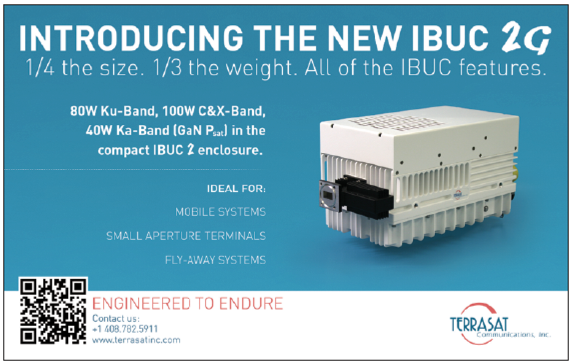On November 28, 2016, 50 years will have passed since the first pre-cursor of the Soyuz spacecraft was launched as Kosmos-133.
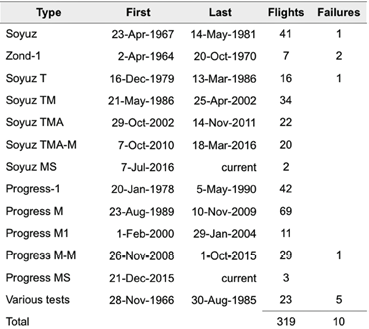
Table 1. Soyuz.
By the time this golden jubilee arrives, this family of rockets will have launched 319 spacecraft.
Over that period of time, a total of 205 cosmonauts from 30 countries will have flown in Soyuz spacecraft, some of them on multiple occasions.
Over the years, the Soyuz spacecraft have been continuously developed to ensure they are up to date with modern technology, but at the same time, their basic form has been maintained. In addition, these rockets have also served as the basis for other spacecraft, in particular the Progress cargo series.
Initially developed as a crewed spacecraft for the USSR’s lunar program as well as that nation’s envisaged space station program, the Soyuz family have supported seven Salyut space stations, the Mir space station and Soyuz is currently the main vehicle supporting the International Space Station.
Origins
The birth of the Soyuz spacecraft can be traced back to the late 1950s when the USSR was looking for a follow-on to the Vostok spacecraft—specific objectives included sending cosmonauts around the Moon and to eventually land them on the Moon. Simultaneously, the new spacecraft was envisaged as a ferry to travel to and from Earth orbiting space stations. Much inspiration came from the work of Konstantin Tsiolkovsky who, in the early 20th century, wrote theoretical works about spaceflight beyond Earth orbit.
As far as can be determined, work on the new spacecraft was initiated in 1958 and was undertaken by Sergei Korolyov’s
OKB-1 design bureau, the precursor of the current Energia corporation.
This was at a time when the United States had embarked on the military Dyna Soar program that ran from 1957 until its cancellation in 1963 and the civilian Mercury program that was started in late 1958.
This was also a period of (misinformed) hysteria about the ‘Soviet lead in space’ and the ‘loss of the high ground’ by the United States and led to efforts of inserting an American into space as quickly as possible.
These efforts were inspired by President John F. Kennedy’s address to Congress on May 25, 1961, when he said, “I believe that this nation should commit itself to achieving the goal, before this decade is out, of landing a man on the Moon and returning him safely to Earth.”
This inspiring statement, undoubtedly strengthened by the President’s assassination on November 22, 1963, triggered the race between the United States and the Union of Socialist Soviet Republics (USSR) to determine whether the words “This is one small step...” or similarly, other words that would become legend… would be spoken by an American or a Russian.

Table 2: Cosmonauts (up to Soyuz MS-02)
However, the USSR did not possess such a strong inspirational commitment and, apart from powerful government meddling, that nation’s effort was hindered by competition within the space industry, in particular between the two major designers, Sergei Korolyov and Vladimir Chelomei.
Lunar Program
OKB-1 responded to the 1958 requirement for a space vehicle and by 1962 the design studies had evolved the basic Soyuz spacecraft, identified as the Soyuz 7K (K = Korabl).Soyuz 7K
The basic Soyuz 7K, as eventually flown on the flights related to the lunar program, consisted of:
1. A living compartment module, designated as Bitovoy Otsek (BO), which had a diameter of 2.26 meters and a length of 2.98 meters (including the docking system). The module provided the cosmonauts with sleeping quarters, laboratory facilities as well as the cargo hold and air lock
2. The instrument and propulsion module, designated as Priborno Agregatniy Otsek (PAO), was comprised of a pressurized instrumentation section and an unpressurised engine compartment. The PAO had a diameter of 2.72 meters and a length of 2.60 meters. The attitude control system used 30 thrusters and the main engine was a KTDU35 with a thrust of 409 kg. There was also a limited performance backup engine to be used in case of emergencies. Two solar arrays of 3.6 x 1.9 meters could be carried, although when the Soyuz spacecraft was being used in conjunction with the Salyut space stations with a shorter flight duration, the solar panels were replaced with batteries
3. A descent module, designated as Spuskaemiy Apparat (SA), which was bell-shaped and had a length of 1.90 meters and a diameter of 2.17 meters. The bell shape provided some aerodynamic lift that allowed the spacecraft to perform 3 to 4 G reentries, although 10 to 16 G ballistic reentries would also have been possible with this craft. Although the capsule was designed for landing on land or water, the landing normally took place over land. Descent was slowed by a parachute—when a 2 mile altitude was attained, small landing rockets would fire to lessen the impact with the landing site.
For the circumlunar mission, this was part of the 7K-9K-11K complex wherein 9K referred to a module that would be placed into a Low Earth Orbit (LEO) with a Proton launch vehicle. Three to four 11K tankers would be launched as follow-ons and would dock with the 9K and transfer fuel, following which the 11Ks would be discarded. This would be followed by the launching of the 7K with a crew, docking with the 9K and then a circumlunar flight. Some reference sources have identified this version of the Soyuz as 7K-OK (for 7 Korabl-Orbital’nyy Korable).
The subsequent program that foresaw a landing on the Moon and was far more ambitious than the earlier circumlunar program was dependent upon the Nosital (N)-1 launch vehicle. In September of 1963, a proposal was made that the OKB-1 match the basic Soyuz spacecraft with the N-1 launch vehicle to achieve crewed landing missions. The program consisted of five stages:
1. L1: six circumlunar flights using the 7K-9K-11K complex, in which the 7K was designated as 7K-L1
2. L2: six flights of an automatic rover vehicle designated as 13K, in combination with the 9K and 11K spacecraft
3. L3: crewed lunar landing using the 7K with a separate landing craft. It would have required one launch with a Soyuz launch vehicle and three launches with N-1
4. L4: a single lunar orbital flight with a modified 7K, to be launched with N-1
5. L5: and advanced lunar rover, launched by a single N-1.
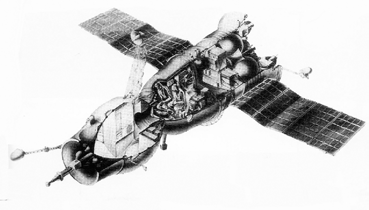
Soyuz 7K.
The other components of the program were the Soyuz Lunova Orbitlny Korably (LOK) lunar orbit cabin, and the Soyuz Lunova Korably (LK) lunar cabin. The Soyuz LOK lunar orbit cabin was to carry the crew to the Moon, remain in lunar orbit and then, after the LK had docked again, fly the crew back to Earth. The mission profile intended to launch the Soyuz LOK and LK combination with an N-1 launch vehicle. Two cosmonauts were to be carried aboard the spacecraft.
From LEO, the fourth stage of the N-1, also designated as the first stage of the Lunova Raket Kompleks (LKR), would send the spacecraft into a trans-lunar trajectory. Powered by a Kuznetsov NK-31 engine, this stage would separate after trans-lunar injection.
The fifth stage, also referred to as the second stage of the LKR, would perform the mid-course corrections as well as the lunar orbit insertion and serve as a braking motor for the lunar landing. This stage would then separate from the LK at an altitude of 2 km, following which the LK would descend on its own.
Once in lunar orbit, one cosmonaut would make a spacewalk to transfer from the Soyuz LOK to the LK. The latter would then separate and descend to the surface of the Moon, using the remaining propellant of the second stage of the LKR to take the LK out of lunar orbit and into a landing trajectory. At an altitude of 1.5 km, the LKR would separate from the LK and impact the lunar surface. An engine on board of the LK would be used for the final landing phase.
Following landing, the single cosmonaut would undertake an EVA of about 90 minutes, wearing a semi-rigid Kretchet spacesuit with a hoop structure that would allow him to regain his upright posture should he fall. After about four hours, the LK would take off from the Moon again, leaving the landing platform behind, and rendezvous with the Soyuz LOK which had remained in lunar orbit. After the transfer of the cosmonaut, the LK would be jettisoned. Using a boost engine, the Soyuz LOK would then be sent into a trans-Earth trajectory. Eventually, the re-entry capsule of the Soyuz LOK would return the two cosmonauts to the surface of the Earth.
When initiated, the program anticipated two low-Earth test flights in1969 and 1970 to test the rendezvous and docking systems of the LOK and LK—the first of three circumlunar flights was planned for 1973. The first lunar landing would have occurred in 1974.
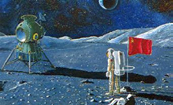
An artistic impression of what never happened.
The program was cancelled in May of 1974 and the principal reason was, apart from the fact the United States had ‘won’ the race to the Moon, were technical problems encountered with the N-1 launch vehicle. Other causes cited included the lack of funds due to a conflict of interests between the military and the Academy of Sciences, on one hand, and designer groups on the other hand. Also suggested was that the OKB-1 design bureau lacked the technological expertise to support the mission.
The first orbital flight of a Soyuz spacecraft, in an uncrewed configuration, occurred on November 28, 1966, as Kosmos-133. The intention was to launch and recover the spacecraft following 33 orbital flights, but the spacecraft failed to stabilize and was destroyed in orbit on November 30,1966, to preventive craft from crashing into Chinese territory.
In spite of the problems encountered with the Kosmos-133, Soyuz-1 was launched on April 23, 1967, with the cosmonaut Komarov on board. The intention was to have Soyuz-1 joined by Soyuz-2 to be crewed by Bykovski, Khrunov and Yeliseyev and that a crew exchange would take place in orbit.
Also suggested was that Soyuz-1 and -2 would dock, or that a formation flight would be made.
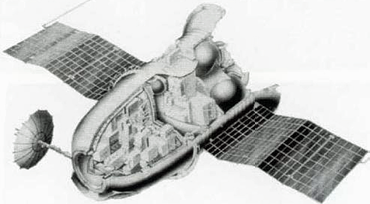
Zond.
The program was designated as Eksperimentalnaya Kosmicheeskaya Stanziya (EKS) which means Experimental Space Station). However, during the flight, which lasted 26 hours, 48 minutes, the solar panels did not properly deploy and caused the thermal system and other systems, including the attitude control system, to malfunction. Nevertheless, Komarov succeeded in putting the spacecraft into a roll for a stabilized re-entry.
A re-entry during the 16th orbit failed and the cosmonaut attempted again on the 18th orbit, on April 24, 1967. During that re-entry, the main and emergency parachutes became entangled and the spacecraft smashed into the ground, killing the cosmonaut. There is, however, also evidence which suggests that the cosmonaut had died prior to, or during, re-entry. Other suggestions include that, under political pressure to achieve the crew transfer in space, the Soyuz-1 flight was made too early for it to be safe.
Following this docking, Kosmos-186/188 and Kosmos-212/213 were tested and about one-and-a-half years later, on October 25, 1968, a crewed attempt was made. Soyuz-2 was launched without a crew, followed the next day by Soyuz-3 with one crew member. The intention was for Soyuz-3 to dock with Soyuz-2—the docking did not take place.
The process of docking was eventually achieved between Soyuz-4 and -5 on January 16, 1969, and two cosmonauts performed a 37 minute tethered spacewalk, during which they transferred from Soyuz-5 to Soyuz-4. To prove that the transfer was actually made, they carried newspapers which were dated after the Soyuz-4 launch.
The docking was attempted again in October 1969 with the Soyuz-7 and -8 flights but, although the two spacecraft came within 480 meters of each other, a failure in the manual controls prevented docking and instead a formation flight was performed.
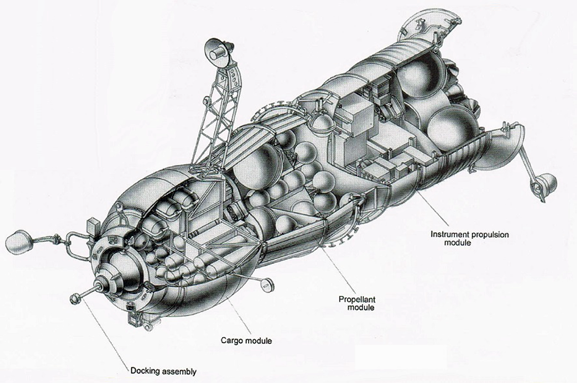
Progress.
At this time, the US had achieved a crewed Moon landing and there have been suggestions that the Soyuz-8 was originally intended to dock with a test article of the Salyut space station, while likely that both Soyuz-7 and -8 were no longer connected with the lunar program. Further flights with the Soyuz spacecraft were clearly associated with space station programs.
As stated earlier, the basic Soyuz spacecraft was also used for a number of circumlunar missions in the Zond program.
Zond
The configuration of the circumlunar Zond spacecraft was similar to that of the Soyuz LOK, consisting of:
1. The Soyuz service module but with a single KTDU-53 engine
2. The re-entry module as for Soyuz
3. A docking collar
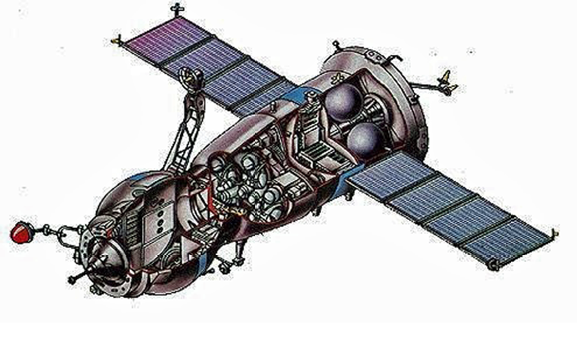
Soyuz T.
Zond was fitted with two solar panels. Some of the other Zond flights may have included the LK module. The program was not very successful and, out of the seven launched Zond spacecraft, only four achieved their objectives.
The first of these, Zond-5, was launched on September 15, 1968, and flew successfully around the Moon on September 18, 1968, when a minimum distance of 1950 km was achieved around the Moon. During this flight, images were also returned from the far side of the Moon.
Eventually the spacecraft re-entered Earth’s atmosphere over the Indian Ocean and was recovered on September 21, 1968. This pattern was repeated with Zond-6 on November 10, 1968, with a new re-entry technique used for a USSR landing rather than in the Indian Ocean. Two more circumlunar flights were achieved by Zond-7 and -8, in 1969 and 1970. The Zond designation was also applied to a variety of spacecraft configurations, including Zond-1 to -3, which had nothing to do with the lunar program and were totally unrelated in design.
Space Station Transfer
For use as a space station crew and cargo transfer vehicle, the solar panels and the toroidal fuel tanks were gradually deleted from the basic Soyuz spacecraft. The interior of the orbital module itself was also changed to reflect the nature of a mission. The initial intention was to fit three seats, as in Soyuz-10, which did not permit the cosmonauts to wear spacesuits. Soyuz-10 docked with the Salyut-1 space station on April 23, 1971.
The disaster with the next flight, Soyuz-11 on June 29, 1971, did cause a change in direction and, until the introduction of the Soyuz T version, all subsequent Soyuz flights were flown by two cosmonauts wearing space suits.
The Soyuz crew transfer spacecraft continued to serve the space station program with crew transfers to Salyut and Mir space stations before graduating to the International Space Station. Initially, the Soyuz spacecraft was not considered flight worthy after a period of 90 days in space, as propellant lines and engine valves would degrade due to exposure to the toxic propulsion chemicals. This feature dictated the comings and goings during the long duration missions which commenced with the Salyut-6 space station.
As a partner in the transfer to space stations, Energia also developed the Progress cargo transfer spacecraft, which was based on the Soyuz spacecraft, and consisted of…
1. A cargo module which replaced the Soyuz’s living compartment module and had a length of 3.15 m and diameter of 2.26 m. With a volume of 6.6 m2, it could carry up to 2480 kg of cargo
2. A refuelling module which replaced the Soyuz’s descent module and which was 2.1 m long and had a diameter of 1.7 meters
3. A propellant section and an instrument module with a length of 3.1 meters and a diameter of 2.72 meters
The entire spacecraft had a length of 7.94 meters and a diameter of 2.72 meters and had a launch mass of about 7,000 kg, but that weight varied with the amount of cargo carried by the craft.
The first Progress spacecraft was launched on January 20, 1978, and docked at the rear port of the Salyut6. Similar to the crewed Soyuz spacecraft, Progress continued to serve the Salyut-6 and -7 space stations as well as Mir and ISS, which were all equipped with facilities for fuel transfers. The propulsion module of the Progress vehicle was also used to boost the space station’s orbit when required.
Progress
Over time, both the Soyuz and Progress spacecraft went through a progressive modernization process, keeping the spacecraft up to date. Soyuz T was the first development and could carry a crew of three cosmonauts wearing non-EVA rated spacesuits.
In addition, two solar panels with a span of 10.60 meters were introduced. Other improvements included a redesigned fuel system and improved avionics.
Soyuz T
The Soyuz TM spacecraft was fitted with the new Kurs docking system. Also, through the use of new parachutes, the payload was increased and more space became available.
In addition, the spacecraft was fitted with the Luchs tracking system and incorporated various other improved instruments, including separate voice channels for each of the cosmonauts.
Soyuz TMA’s main improvement was to accommodate seating for taller cosmonauts, hence, A = Anthropometricheski. In addition, the solar arrays were extended to a span of 10.7 meters. The subsequent Soyuz TMA-M version carried improved avionics, data processing and cooling systems.

Jos Heyman, a retired accountant, is the Managing Director of Tiros Space Information (TSI), an Australian consultancy specializing in the dissemination of information on the scientific exploration and commercial application of space for use by educational as well as commercial organizations. He has more than 40 years of experience in the historical aspects of astronautics and is the editor of the TSI News Bulletin. Jos Heyman was born in the Netherlands and has been an Australian citizen since 1969.


